Oh, hey, look: ANOTHER Final Fantasy soundtrack. What’s on offer this time? Battle themes, world themes, melodramatic moment themes, menu themes, and that obligatory choral end-boss world-in-crisis disasterpiece. Ho-hum.
I’ve made it clear in the past that I am over Final Fantasy music for the most part, so if you read the above with some shred of sincerity, you are absolutely forgiven. But then comes the question: why would I review not only a Final Fantasy soundtrack but one that is inevitably going to be a rehash of old themes? Why would I almost beg Jayson to give me this review just so that I could get my grubby little paws on the music a week or two before release?
…Because there’s always a chance this album would be the rare, beautiful butterfly for which my eager pins have been waiting. Want to see me mutilate the latest from the world’s most enduring series of game music? You know what to do.
Aw, who am I kidding? I’m a massive Dissidia: Final Fantasy (D:FF) fan. I’d say fanboy but I think my approach to the game is a little more mature than that. Fanman? That’s just weird. Anyway — I adored the first game. Poured hundreds of hours into the Japanese version, even wrote a fan review of it on a site usually meant for FAQs (kudos if you can guess which — review, that is). This was before my time with OSV, else I might have reviewed the D:FF OST…
But that would make me a hypocrite. I so loathed some of Takeharu Ishimoto’s remixes in D:FF that I hunted down shameful ways of modifying the game’s music. Not all the tracks got the chop, but “Those Who Fight Further” (aka “Still More Fighting,” FFVII) and “Don’t be Afraid” (FFVIII) both irked me with Ishimoto’s techno approach. Whether or not he’d maintain that with Dissidia 012 [duodecim] Final Fantasy (012) would be a major factor as to how I receive this album. Another would be whether I’d treat it as an arrangement album, a compilation album (since it has some tracks taken straight from the original games) or a new album showcasing Ishimoto’s contributions via the 012-only themes. In the end, of course, I had to do all three.*
By now I hope you’ve all watched Jayson unpack the soundtrack box. Please bear with me as I unpack the music inside it.
And there’s quite a lot (see the official site for a full listing and samples and here for the tracks in English). 64 tracks over two discs, which results in some fairly short tunes, notably the arrangements — almost nothing over 3 minutes on the first disc (44 tracks). The second disc (20 tracks), which tellingly has the endboss tune and the ending itself, is far more luxurious, and occasionally too indulgent with the ‘un’original tracks such as those cribbed from Final Fantasy XI. A minor quibble, perhaps.
I was halfway through one-more-listen to Ishimoto’s arrangement of “Blinded By Light” (FFXIII) on this OST when I realized I’d made a mistake when judging D:FF‘s music. Those techno elements (some of which I think resemble parts of FFXIII’s “Defiers of Fate”) can work if you view them as what I call the Dissidian aesthetic. Imagine: if someone comes to you and asks you to arrange/improve the most beloved game music of the most beloved series and says that it’s for an action/fighting game aimed at the fans who truly love that series, you could do far worse than employ a technique that simultaneously lightens and enlivens the music. This is the case for not only “Blinded by Light” but also “Battle theme” (FFVI), “Neo Exdeath/Final Battle”(FFV) and “J-E-N-O-V-A” (FFVII). Regarding the latter: yes, the Black Mages version is better, but as I’ve said, I’m learning to appreciate Ishimoto’s method of claiming this music as Dissidian.
That said, there’s a confidence to Ishimoto’s arrangements here that I found lacking in D:FF. Take his balls-to-the-wall shredface-franticpace I,Ishimoto,willknockyouALLdown “Chaos Shrine” (FFI) — heavier FF music is not to be found anywhere outside of doujin, and yet right under the nose of breakneck metal the strings and muted brass insinuate the source theme without letting it take over. This sort of synthesis reminds me immediately of Yoshimi Kudo’s work on the Sekaiju no MeiQ 3 arrange album and thus (you saw this coming, right?) JDK Band.
“Pandemonium Castle” (FFII) and “Crystal Cave” (FFIII) are less adventurous: grand horns, tubular bells and cymbals a-plenty. The former reminds me of Mitsuda’s battle theme from Xenosaga Episode 1 and the latter gains impetus by foregrounding the new ostinato while the strings of the original melody skate over the harder pace. The same horns undertone is maintained throughout “Battle 1” (FFIII), making it almost a sister-piece, which is a nifty touch. “Contest of Aeons” (FFX) is more powerful and complex than Junya Nakano’s original, with a stronger edge given to the ‘Hymn of the Fayth’ undertone. “Esper Battle” (FFXII) was already a highlight of Final Fantasy XII to me, but Ishimoto identifies where Hitoshi Sakimoto could have been gutsier with the momentum and turns the noble but stilted original into a battle theme appropriate to 012.
“Force Your Way” (FFVIII) was originally synth-heavy, has been arranged orchestrally and was beefed up by the prog-metal of the Black Mages. Here, Ishimoto wisely chooses a middle-ground arrangement, accentuating the drums and downplaying the organ, a distorted version of which carries the melody, with the whole thing teased by all sorts of little flourishes along the way. It might not be the revelation that was The Oath in Felghana‘s “Sealed Time,” but that’s not a damaging comparison.
“A Realm of Emptiness” (FFXI) is from a game I wouldn’t ever play but it did make me chase down the original by Naoshi Mizuta. Ishimoto’s version is a lot shorter and a lot better. Perhaps because it’s made for an MMO where battles can sort of drag on, the original feels weary to me, whereas Ishimoto gets to the point and brings what is good about the original into unrelenting focus.
The most difficult to judge was “Saber’s Edge” (FFXIII). On the first listen or two, it really doesn’t sound any different to me than Hamauzu’s original, which was already one of his finest moments. I literally had to clear all my music out and put the two next to each other, and of course that was when the improvements became obvious. The first half is the same, albeit somewhat cleaner, but around halfway Ishimoto beefs the drums right up and, as mentioned before, ‘Dissidia-fies’ the music. It would be easy to dismiss this track because of the similarities to the original, but I feel a little wiser for not doing so.
A special mention must go to my all-time favorite battle theme from Final Fantasy, “Battle 1” (FFIV). This was my first ever FF battle theme and I’ll never forget how I’d never heard anything quite like it. It’s been arranged and rearranged since, but Ishimoto displays a spark of real genius with the choice of piano here: it handles the light melody and rising chords with equal deftness, supported by unobtrusive strings and softened percussion. This is a technically simple piece reflecting what to me was a simpler, even naïve Final Fantasy, before people started questioning the angst and despair of FF protagonists. If this were just an arrangement album, Final Fantasy IV‘s battle theme would be the cherry on top for me.
Then there are what can be loosely-termed as the ambient arrangements. Ishimoto elevates the classic “Matoya’s Cave” (FFI) with a pleasant strings progression of the original theme suspending an innovative acoustic guitar rhythm. “The Mystic Forest” (FFVI) has a simple but effective harpsichord introduction, while “Find Your Way” (FFVIII) is more subtly revisited with echoes of choir and cello. “Forested Temple” (FFVII) is faithful to the original although it has a certain weight Uematsu’s version lacked, a tone very reminiscent of “Fithos Lusec Wecos Vinosec” from the parade scene in Final Fantasy VIII. And “A Place to Call Home” (FFIX) starts a little abruptly but settles into palatable chanting and primal percussion. Nice but nowhere near as impressive as some of the other arrangements.
Not everything is rosy in the land of Dissidian interpretation. “Suspicion” (FFIV) suffers from what sounds like a theremin, and it’s not as if the piece wasn’t eerie enough. Downright boring drums straight out of an 80s ballad almost beat the delicate but resolute heart of “Tifa’s Theme” (FFVII) to a lazy death. “Grand Cross/Final Battle” (FFIX) is overcooked and out-of-place; an arrangement of “The Dark Messenger” would have been better but since the original is already in the game, that’s not happening. “Julia” (FFVIII) might fit Laguna’s inclusion thematically but it’s so brief and uninspired it just makes me wish Rinoa had made it into the 12th War so that Squall could stop with the Lone-Lion routine and keep his Eyes On Her. “Yuna’s Theme” pares itself back to a music-box style melody and It Isn’t all that Beautiful (and the inclusion of the original “A Fleeting Dream,” a far superior rendition of the theme, really doesn’t help).
Despite hiccups, 012 the arrange album hits more often than it misses, even if Ishimoto as an arranger is an acquired taste, almost deceivingly facile at times.
Seeing how these young upstarts sit next to their less-technically advanced elders is quite interesting. The structure of the album is almost poetically metered: one 012 track, one to three arrangements and an original or two from a game, repeat until game=XIII. This creates an instant contrast between the original composer’s clay and Ishimoto’s mold. Most fascinating to me is how the technology slowly catches up — resulting in less arrangements for the latter games, I suppose. I am happy with most of the choices (“You’re Not Alone” [FFIX] is just incredible as it is, for example), but still feel that things get a bit lazy towards the Final Fantasy XI stage and onwards. If you have the OSTs, these tracks are generally negligible but their inclusion in the game is welcome.
Far less negligible, of course, are the 012 tracks. It’s extremely rewarding to see what Ishimoto can do when he’s unleashed from the yoke of compulsory arrangement, handed an orchestra and a something-I-won’t-name-yet. According to a forthcoming interview OSV conducted with Ishimoto, ten tracks were recorded overseas, several in Prague, and he oversaw them personally. And you can really tell. As was hinted at with his Crisis Core work, Ishimoto the composer is vastly superior to the arranger.
012 as a true OST is where I really get to gush. I loved the Dissidia-original music in D:FF and thought it must have really pushed Ishimoto to come up with themes that could not only sit next to all these iconic tunes but actually serve as the thematic glue. With 012, he evolves established Dissidia themes in occasionally predictable but never inappropriate ways. “Lux Concordiae” is a choral rendition of the main theme so majestic it can look the actual “Final Fantasy” theme in the eye and maybe even wink; “The Last Decision” slows the same theme right down with the gravitas of a world’s fate hanging in the (un)balance. “Reform” is D:FF‘s menu music on a power trip, and “Dissidia opening/edit,” featured in various iterations in the trailers (more on that in a bit), is so layered it makes the first game’s opening seem almost one-dimensional, despite being two minutes shorter — although you’d have to listen to both to realize this. Do so, however, because it will give immense appreciation for Ishimoto’s ability to improve not only the work of others but his own, which is less-obvious a skill than you might at first think.
Okay, now I’m really, really going to gush. Ishimoto’s entirely new music for 012 has done the impossible: it’s made me hope that there will be more Final Fantasy concerts in the future — or at least more non Uematsu-centric FF concerts. Nobuo Uematsu is a genius. He started all this and made it happen, but I really feel no need to continue singing the praises of the Godfather when the next potential Don is in dire need of championing. Fine, the punny title (maybe Who-ematsu might have been better?) was a little exaggerated, but once I reached one particular track on this album, I knew the ‘repeat’ button was in for some serious abuse. “Cantata Mortis & God in Fire” are actually sampled on the website as ‘bgm2’ and ‘bgm3.’ “Cantata Mortis” portrays Ishimoto in full Shimomura mode by way of the Orff-ully epic “Destati,” while “God in Fire” is the replacement for Your Favorite Enemies’ rather misplaced rock song from the first game. “The Messenger” wasn’t terrible, but Dissidia’s Big Bad deserved better. One-Winged Wannabes seem abundant these days, blending orchestra, choir and rock, but Ishimoto keeps the two separate here, with one leading into the other in a way that turns the otherwise above-average song “God in Fire” into something very awesome indeed. Mind you, I’m a well-known sucker for power/symphonic metal elements: strong female vocals (Nightwish), chunky riffs (Kamelot), faux-choir (Epica) and silly lyrics about gods warring, endless sorrow and the abyss. To me, “Cantata Mortis & God in Fire” is a theme worthy of the incarnation of Chaos. I’ve been driving around the past week or two singing along to what is now my favorite FF track…and that is no exaggeration.
I’ve decided not to spoil the ten-minute ending, because I envy you who (hopefully) will experience it in its proper context, after many hours of waging the 12th War between Cosmos and Chaos. And, hey, if you don’t plan on that, I did just say ‘ten-minute ending’ and 012 is a mash-up of 13 Final Fantasies…
Almost an afterthought: the Limited Edition I reviewed comes with a third bonus disc, the tracklist of which you can also find on the website. Its most appealing feature is the overture, used on the site as ‘bgm1,’ but there are also a few unreleased trailer tracks, none of which hurt in the slightest, and “Cantata Mortis” separated from “God in Fire” — not something I’d recommend at all. “Cantata Mortis” without “God in Fire” after it sounds like all build-up and little pay-off, despite the climax of pounding timpani and full-bore chorus; “God in Fire” by itself, judging by some reactions I’ve seen around the place already, might seem cheesy. I tend to avoid these two versions.
As ever, I appreciate your attention and indulgence of my lengthy assessments. Being a writer, I despise the concept of tl;dr, but in this case, I’m going to give you one anyway:
tl;dr: middling-to-excellent arrangement album, superfluous but intriguing compilation album, downright spectacular (if short-lived) original album.
Test results: 12 goes past 11 but 1-13 have more past than 012. 012, however, has an unnecessary zero, which makes it enigmatic, frustrating and occasionally mind-blowing.
Your conclusions may vary.
The album is currently available from CD Japan (Limited Edition, Regular Edition) and Play-Asia (Limited Edition, Regular Edition).
___
*I’ve put a present near the bottom of this review for those of you who don’t want to read what I’ve written. Which makes me wonder why you clicked ‘more.’ Hm.
Tags: 012, Dissidia, Duodecim, Final Fantasy, Ishimoto, Music Reviews, Soundtrack, Square Enix, Takeharu Ishimoto





























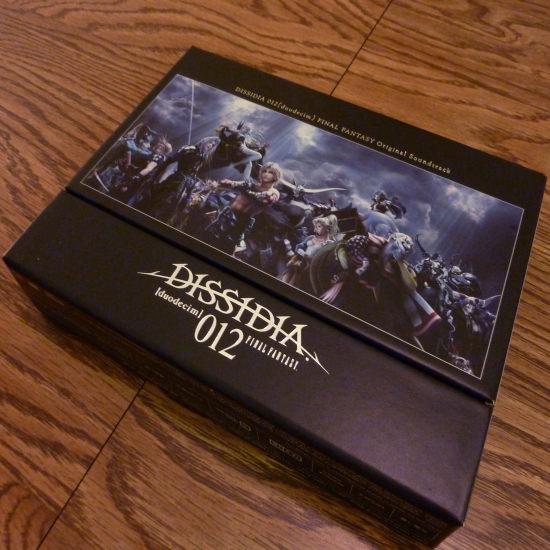
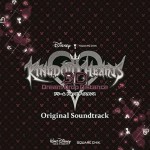
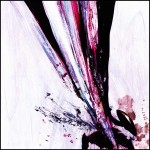
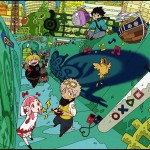
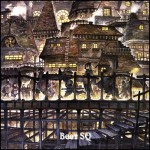







I’ve never been a fan of Dissidia, so when it comes to the albums, I jump right to the arrangements. Didn’t care too much for the first game’s arrangements, but the ones here are fantastic. I just wish they were longer!